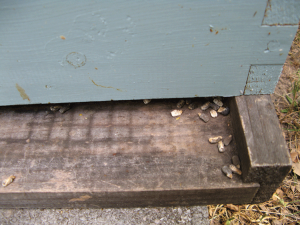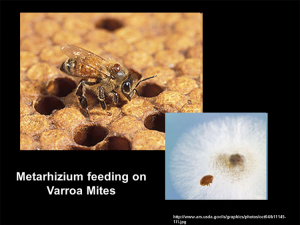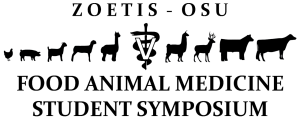By: Ross Conrad
The relationship is a complicated one…
The honey bee has an interesting relationship with fungi. Some fungi are harmful to bees while other fungi are beneficial and can even be essential to honey bee health. In this article we explore some of the interactions between bees and some members of the mushroom family.
Chalkbrood
Most beekeepers are familiar with the honey bee fungal disease chalkbrood that is caused by the fungus, Ascosphaera apis. Thanks to increases in global travel and trade, as well as the migratory nature of many beekeeping operations, chalkbrood is found in honey bee colonies all around the world.

Mummified larval remains from chalkbrood are the most common fungi beekeepers notice in their hives.
Chalkbrood was first identified in the United States in the beehive state of Utah in 1965 (Baker and Torchio 1968) although evidence indicates that it was present in U.S. territories long before then. (Gilliam, et. al., 1997) Over the years, chalkbrood has spread throughout the U.S. including Alaska and Hawaii.
Chalkbrood only infects larvae that are less than one week old who consume the spores in the food they are provided by nurse bees. Older larvae and adult bees are resistant to the disease. While Ascosphaera Apis is fatal to the young larvae that ingest it, the disease does not typically cause the death of the entire colony, although severe cases can weaken a colony significantly. Impacts of chalkbrood on a hive can be variable both due to the health and tolerance of the colony infected, and due to the fact that there are multiple strains of chalkbrood and they vary in virulence (how fatal they are to the host) and fitness (how quickly, and how many reproductive spores they can produce). (Glinski 1982; Evison, S. E. F. et. al. 2015)
Chalkbood is associated with colony stress and with cool, moist and humid conditions. (Mehr et al., 1976; Gilliam et al., 1978; Puerta et al., 1994; Flores et al., 1996 ; Borum and Ulgen, 2008) As a result, infection commonly occurs in spring and in hives that are poorly ventilated or located in badly drained or shaded apiaries.
The roots (mycelium) of A. apis consumes infected larvae and at first it becomes soft and fluffy. The mycelium eventually mummify the larvae and turn it into hard white lumps resembling a small piece of chalk. The color of the mummified larvae will turn grey and black as the fungus enters its spore producing stage. A black mummified larvae can contain hundreds of millions of chalkbrood spores. (Hornitzky, 2001) The remains of infected larvae can be found in brood cells, on the bottom board and in front of the hive entrance as it is cleaned out by worker bees.
Pathogen transmission can occur through adult bees within and between colonies, primarily through food sharing and through beekeepers transferring infected equipment between colonies. (Gilliam and Vandenberg 1997) Spores are found in beeswax, pollen, and honey and have been shown to remain viable for at least 15 years. (Gilliam, 1986; Gilliam and Taber, 1991; Anderson et al., 1997; Flores et al., 2005a ; Flores et al., 2005b) Feeding colonies honey harvested from infected hives can also spread the disease since spores have been shown to remain viable in honey even after two years of storage. (Gilliam and Vandenberg 1997) Thankfully there are no honey bee diseases that can infect humans.
While there are no registered chemicals available for treating colonies infected with chalkbrood, beekeepers have been able to clear the disease using a variety of methods. These methods include using hygienic bees, re-queening (especially with a young queen from a hygienic colony), locating apiaries in well-drained areas and in full sun, rotating old comb out of the hive on a regular basis, and avoiding the transfer of combs between infected and uninfected colonies. Since the condition often clears up on its own once a strong nectar flow is initiated, feeding bees sugar syrup is sometimes used by beekeepers to help clear chalkbrood symptoms from infected colonies, though spores remain.
Studies also indicate that essential oils containing citral, geraniol (found in lemongrass oil) and citronellal have an inhibiting effect on fungal growth in vitro. (Calderone et al., 1994; Davis and Ward, 2003). While additional research is needed to confirm such beneficial effects in the field, some beekeepers are experimenting with using bee products that contain lemongrass oil such a Honey-B-Healthy and Pro-Health from Mann Lake Bee Supply to help clear colonies of chalkbrood.
While some folks may be tempted to seek a fungicide to control fungal hive diseases such as chalkbrood, a wealth of research indicates that a dependence on synthetic pesticides and antimicrobials can lead to general deterioration of the colony environment and bee health in general, therefore minimizing the use of pesticides inside and outside of bee colonies is recommended. (Bogdanov et al., 1998; Bogdanov et al., 2004; Frazier et al., 2008)
While I have often seen cases of chalkbrood in my bees, the infection has typically been quite mild and I have never had to take any special steps to control it. Last year however, I experienced a hive that had the most severe case of chalkbrood I have ever seen. The colony was weak and struggled most of the summer until it eventually went queen-less. Thankfully, not all fungi are detrimental to honey bee colonies and some may actually be an asset.
Fungi for Varroa Control
 Studies conducted at Cornell University have found that the entomopathogenic fungi Metarhizium anisopliae and Hirsutella thompsonii, kill Varroa mites when applied to colonies but do little harm to bees due to the fact that bees are meticulous groomers and readily remove the fungi spores from their bodies preventing infection. (Kanga, L.H. et. al. 2002, Kanga, L.H et. al. 2003) Researchers found the fungi took at least several days before it became effective on the mites and was active for at least 42 days after application making them not only a potentially safe bio-pesticides, but long lasting ones. This indicates that entomopathogenic fungi do not provide a quick, “flash kill” like so many of today’s commercial Varroa mite controls, rather they suppress pathogens and tend to work relatively slowly to kill mites over time.
Studies conducted at Cornell University have found that the entomopathogenic fungi Metarhizium anisopliae and Hirsutella thompsonii, kill Varroa mites when applied to colonies but do little harm to bees due to the fact that bees are meticulous groomers and readily remove the fungi spores from their bodies preventing infection. (Kanga, L.H. et. al. 2002, Kanga, L.H et. al. 2003) Researchers found the fungi took at least several days before it became effective on the mites and was active for at least 42 days after application making them not only a potentially safe bio-pesticides, but long lasting ones. This indicates that entomopathogenic fungi do not provide a quick, “flash kill” like so many of today’s commercial Varroa mite controls, rather they suppress pathogens and tend to work relatively slowly to kill mites over time.
Numerous trials have been conducted in an effort to find effective application methods. Hives made with mushroom mycelium in compressed sawdust and pieces of cardboard inoculated with mycelium of M. anisopliae have both been tested. (Kanga L.H. et. al. 2006) Better results appear to have been obtained through the conventional delivery system that beekeepers are already familiar with for various hive products: sugar patties. Containing the fungi within the patties seems to help protect the fungal spores from brood nest temperatures and has shown to be an improvement over the cardboard and compressed sawdust hive components application systems when introducing the biopesticides into bee hives. (Kanga, L.H. et. al. 2010)
One company, Strong Microbials out of Milwaukee, Wisconsin, is currently working on a fungal containing product called BioVar®. BioVar® is a biopesticide is made up of two entomopathogenic fungi (Metarhizium anisopliae and Beuavaria bassiana) and three spore forming bacilli [Bacillus sphericus, Bacillus thuringensis (krustaki), and Bacillus thuringensis (israeliens)]. BioVar® is a dried powder that is mixed with powdered sugar and applied to colonies. The fungi and bacterium in the product are intended to work together to suppress the mites and the additional burden of Varroa associated viruses often referred to as parasitic mite syndrome (PMS) in hives. (Hamiduzzaman, et. al., 2012)
While Strong Microbials is pursuing EPA registration for BioVar® they have run into the usual challenges of getting the product to work consistently. The difficulties applying fungi as a biopesticide inside the hive are significant. First manufacturers have to develop packaging so that the fungi have a long shelf life and can be applied by beekeepers into hives easily and effectively. Then there are the additional challenges of figuring out the optimum timing for treatments and optimum dosage. Previous researchers have found the viability of fungal spores has tended to decline during application, and low rates of infection of the phoretic mites has taken place due to the honey bee controlled temperature and humidity inside the hive. Consequently, Strong Microbials expect that the best application method will target reproducing mites within the larval cell, and are currently testing this approach. While Mr. Slava Strogolov, CEO of Strong Microbials, keeps a research apiary in Milwaukee, WI, the company also recruited 50 beekeepers in different states to help facilitate the testing of this potential product.
Meanwhile, research has shown that the beneficial fungi that exists in the honey bee digestive tract and are used to help ferment pollen into bee bread are adversely affected by standard colony inputs such as high fructose corn syrup, formic acid and oxalic acid. (Yoder, J.A. et. al. 2008) This suggests common hive inputs may adversely affect microbial based biopesticides as well.
Additional research has already confirmed the harmful impacts of antibiotics on the microbiome that exists in the honey bee’s gut. (Raymann, K. et. al. 2017) This research implies that foraging bees that are exposed to fungicides, and pollen with fungicide contamination, could also be a complicating factor in the successful use of fungal biopesticides for Varroa control.
Mushrooms and Honey Bee Health
Honey bees are known to visit wine cap mushroom beds (Stropharia rugoso-annulata) and suck up the sweet secretions of the mushroom’s mycelium. This has led some researchers to suspect the nutritional support that fungal extracts can offer may be able to play a significant role in improving and maintaining bee health.
Steve Sheppard and Brandon Hopkins at Washington State University, have teamed up with Paul Stamets of the company Fungi Perfecti, to not only conduct their own tests of various methods of using and applying entomopathogenic fungi for Varroa control, and also whether certain mushroom extracts can help bees confront PMS. Initial findings suggest that there are a number of species of wood-rotting fungi may help reduce honey bees viruses and increase their lifespans including Reishi (Ganoderma lucidum), the Red-Belted Polypore (Fomitopsis pinicola), and Amadou (Fomes fomentarius) mushrooms.
Tests are being conducted by adding mushroom extracts to water that is fed to colonies. The folks at Fungi Perfecti are hoping to have a new product targeted to honey bee pathogens sometime in 2018 if not sooner.
Despite its challenges, use of fungi in honey bee colonies is not far-fetched given the discovery of stingless bees from Brazil that feed on a certain fungus in a way that parallels fungus farming insects. (Menezes C. 2015) The symbiosis between bees and fungi appears to be more frequent than has previously been believed and continues as a growing area of interest and study.
References
Anderson, D.L., Giacon, H., Gibson, N. (1997) Detection and thermal destruction of the chalkbrood fungus (Ascosphaera apis) in honey. Journal of Apicultural Research. 36, pp. 163–168
Baker, G.M., Torchio, G.M., (1968) New records of Ascosphaera apis from North America. Mycologia, 60, pp. 189–190
Bogdanov, S., Kilchenmann, V., Imdorf, A. (1998) Acaricide residues in some bee products. Journal of Apicultural Research, 37, pp. 57–67
Bogdanov, S., Kilchenmann, K., Seiler, K., Pfefferli, H., Frey, T.H., Roux, B., Wenk, P., Noser, J. (2004) Residues of para-dichlorobenzene in honey and beeswax. Journal of Apicultural Research, 43 (1), pp. 14–16
Borum, A.E., Ulgen, M. (2008) Chalkbrood (Ascosphaera apis) infection and fungal agents of honey bees in north-west Turkey. Journal of Apicultural Research, 47 (2), pp. 170–171
Calderone, N.W., Shimanuki, H., Allen-Wardell, G. (1994) An in vitro evaluation of botanical compounds for the control of the honeybee pathogens Bacillus larvae and Ascosphaera apis, and the secondary invader B. alvei. Journal of Essential Oil Research. 6, pp. 279–287
Davis, C., Ward, W. (2003) Control of chalkbrood disease with natural products: a report for the RIRDC. Publication No. 03/107, Kingston, ACT, AU, pp. 1–23.
Evison, S. E. F., Foley, K., Jensen, A. B. and Hughes, W. O. H. (2015), Genetic diversity, virulence and fitness evolution in an obligate fungal parasite of bees. Journal of Evolutionary Biology, 28: 179–188. doi:10.1111/jeb.12555
Flores, J.M., Ruiz, J.A., Ruz, J.M., Puerta, F., Bustos, M., Padilla, F., Campano, F (1996) Effect of temperature and humidity of sealed brood on chalkbrood development under controlled conditions. Apidologie, 27, pp. 185–192
Flores, J. M., Spivak, M., Gutierrez, I (2005a) Spores of Ascosphaera apis contained in wax foundation can infect honeybee brood. Veterinary Microbiology, 108, pp. 141–144
Flores, J.M., Gutierrez, I., Espejo, R (2005b) The role of pollen in chalkbrood disease in Apis mellifera: transmission and predisposing conditions. Mycologia, 97, pp. 1171–1176
Frazier, M., Mullin, C., Frazier, J., Ashcraft, S. (2008) What have pesticides got to do with it? American Bee Journal, 148, pp. 521–523
Gilliam, M. (1986) Infectivity and survival of the chalkbrood pathogen, Ascosphaera apis, in colonies of honey bees, Apis mellifera. Apidologie, 17 (2), pp. 93–100
Gilliam, M., Taber, S. (1991) Diseases, pests, and normal microflora of honeybees, Apis mellifera, from feral colonies. Journal of Invertebrate Pathology 58 (2), pp. 286–289
Gilliam, M., Lorenz, J., Werner, A.M., Thorp, R.W., (1997) Occurrence and distribution of Ascosphaera apis in North America: chalkbrood in feral honey bee colonies that had been in isolation on Santa Cruz Island, California for over 110 years. Apidologie, 28, pp. 329–338
Gilliam, M., Vandenberg, J.D. (1997) Fungi. Roger Morse, Kim Flottum (Editors), Honey Bee Pests, Predators, and Diseases (third ed.), AI Root, Ohio, OH. pp. 81–110
Gilliam, M., Taber, S., Rose, J.B. (1978) Chalkbrood of honeybees, Apis mellifera L., a progress report. Apidologie, 9 (1), pp. 75–89
Glinski, Z. (1982) Studies on pathogenicity of Ascosphaera apis for larvae of the honeybee Apis mellifera L. Part II. Relationships between biochemical types and virulence of A. apis. Annales Universitatis Mariae Curie Sklodowska Sectio DD. Medical Vet., 37 (8), pp. 69–77
Hamiduzzaman, M.M., Sinia, A., Guzman-Novoa, E., Goodwin, P. (2012) Entomopathogenic fungi as potential biocontrol agents of the ecto-parasitic mite, Varroa destructor, and their effect on the immune response of honey bees (Apis mellifera L.). Journal of Invertebrate Pathology. 11(3):237-243
Hornitzky, M. (2001) Literature review of chalkbrood. A report for the RIRDC. Publication No. 01/150, Kingston, ACT, AU
Kanga, L.H., James, R.R., Boucias, D.G. (2002) Hirsutella thompsonii and Metarhizium anisopliae as potential microbial control agents of Varroa destructor, a honey bee parasite. Journal of Invertebrate Pathology. 81(3):175-84.
Kanga, L.H., Jones, W.A., James, R.R. (2003) Field Trials Using the Fungal Pathogen, Metarhizium anisopliae (Deuteromycetes: Hyphomycetes) to Control the Ectoparasitic Mite, Varroa destructor (Acari: Varroidae) in Honey Bee, Apis mellifera (Hymenoptera: Apidae) Colonies. Journal of Economic Entomology, 96(4): 1091-1099
Kanga, L.H., Jones, W.A., Gracia, C., (2006) Efficacy of strips coated with Metarhizium anisopliae for control of Varroa destructor (Acari: Varroidae) in honey bee colonies in Texas and Florida. Experimental and Applied Acarology 40(3-4):249-58.
Kanga L.H., Adamczyk J, Patt J, Gracia C, Cascino J. (2010) Development of a user-friendly delivery method for the fungus Metarhizium anisopliae to control the ectoparasitic mite Varroa destructor in honey bee, Apis mellifera, colonies. Experimental and Applied Acarology, 52(4):327-42. doi: 10.1007/s10493-010-9369-5.
Mehr, Z., Menapace, D.M., Wilson, W.T., Sacket, R.R. (1976) Studies on the initiation and spread of chalkbrood within an apiary. American Bee Journal, 116, pp. 266–268
Menezes, C., Vollet-Neto, A., Marsaioli, A.J., Zampieri, D., Fontoura, I.C., Luchessi, A.D., Imperatriz-Fonseca, V.L. (2015) A Brazilian Social Bee Must Cultivate Fungus to Survive, Current Biology, 25 (21): 2851-2855 DOI: http://dx.doi.org/10.1016/j.cub.2015.09.028
Puerta, F., Flores, J.M., Bustos, M., Padilla, F., Campano, F. (1994) Chalkbrood development in honeybee brood under controlled conditions. Apidologie, 25, pp. 540–546
Raymann, K., Shaffer, Z., Moran, N.A. (2017) Antibiotic exposure perturbs the gut microbiota and elevates mortality in honeybees. PLOS Biology https://doi.org/10.1371/journal.pbio.2001861
Yoder, J. A., Christensen, B. S., Croxall, J., Sammataro, D., (2008) Suppression of growth rate of colony-associated fungi by high fructose corn syrup feeding supplement, formic acid, and oxalic acid. Journal of Apicultural Research 47(2): 126-130
Ross Conrad is the author of Natural Beekeeping: Organic Approaches to Modern Apiculture, 2nd Edition (2013).










